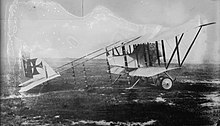Caudron G-III
| Caudron G.III | |
|---|---|

|
|
| Type: | Scouts, bombers |
| Design country: | |
| Manufacturer: | |
| First flight: |
December 1913 |
| Commissioning: |
1914 |
| Production time: |
1914-1916 |
| Number of pieces: |
approx. 2850 |
The Caudron G-III was a French military plane in the First World War .
development
The one and a half-decker Caudron G-III initially had a wing twist for steering around the longitudinal axis, but this was soon replaced by ailerons . The pilot and the observer sat one behind the other in the open cockpits of a rear-capped fuselage gondola with the engine installed in the nose. Double fin and rudder were mounted on four tail booms, the lower pair of which also acted as runners for the undercarriage, which consisted of two pairs of wheels.
Pre-war missions
The brothers Rene and Gaston Caudron and their company "Société des aeroplanes Caudron" in Issy-les-Moulineaux have been producing aircraft since 1909. In December 1913, the G-III flew a loop for the first time , in May 1914 a Caudron G-III in Le Crotoy surpassed the long-term flight record held by German aircraft with 16 hours and 28 minutes. The concept was based directly on the G-II developed from the Type B in 1913. It was preceded by around twenty different types, of which around 150 were built.
War effort
Even before the outbreak of the First World War, the Escadrille C.11 in Montmédy had already been equipped with G-IIIs, and several aircraft had been exported to Denmark and China . Large-scale production of the G-III has now started. The Escadrilles C.17, C.18 and C.30 have now also been fitted with it. The pattern was initially distributed as the G-IIIA.2, i.e. as a two-seater reconnaissance aircraft and artillery observer, and proved to be very robust. In the version G-IIIB.2, the Caudron was also used as a bomber. G-III flew missions on the Western Front, in Russia and in the Middle East.
Because of her low armament and speed, she was withdrawn from the front lines of the French air force in mid-1916 . The Italian Air Force used the G-III as a reconnaissance aircraft until 1917. British G-IIIs remained in service as combat bombers until October 1917. After the withdrawal from the front units, the G-III version E.2 or D.2 was used as a training aircraft or advanced trainer. Around 17,000 pilots are said to have been trained on the Caudron G-III.
French production amounted to 2,450 G-IIIs, 1,423 of them from Caudron itself, the rest from French licensees. Caudron's subsidiary British Caudron in Great Britain built 233 more machines, 124 of which went to the Royal Flying Corps (RFC) and 109 to the Royal Naval Air Service (RNAS), where they were in service until the end of 1916 and 1917 respectively. The Italian company AER built another 166 G-III as G-III.12 under license with 100 HP Anzani 10 engine. In Germany, Gotha built copies of the G-III under the factory designations LD.3 ( = Land Doppeldecker ) and LD.4 .
In addition to the Aéronautique Militaire , the Belgian , Italian , Russian , Serbian, US Air Force , British Army and Naval Aviation , Finnish, Polish and numerous other air forces used the Caudron G-III. The plane has been flown in 21 countries around the world.
Post-war whereabouts
Some caudron were still used in the armed conflicts in China and Manchuria after 1918 ; nothing is known about their whereabouts.
On January 19, 1919, the pilot Jules Védrines landed his G-III on the 28 m long roof terrace of the Galeries Lafayette in Paris. He fulfilled a competition that the department store had advertised before the First World War and received prize money of 25,000 francs. However, his plane was damaged in the process and he had to pay a fine for illegally flying over the capital. The event is narrated in a short film.
The aviator de la Roche set the women's altitude record with a G-III with 3900 m and Adrienne Bolland crossed the Andes on April 1, 1921 with such a machine. On July 30, 1921, François Durafour landed with a Caudron G-III at the Dôme du Goûter , 4303 m high , a secondary summit of Mont Blanc .
Today G-III belong to the holdings of the RAF Museum in Hendon , the Musée de l'air et de l'espace in Paris , the Royal Army and Military History Museum in Brussels , the Museu Aeroespacia in Rio de Janeiro and the Hallinportti Aviation Museum in Finland .
Technical specifications
| Parameter | Data |
|---|---|
| crew | 2 |
| length | 6.40 m |
| span | 13.40 m |
| height | 2.50 m |
| Wing area | 27.00 m² |
| Empty mass | 447 kg |
| Takeoff mass | 735 kg |
| Standard engine | an air-cooled rotary motor Clerget or Gnôme-Rhône |
| Starting power | 59 kW (80 PS) |
| Top speed | 115 km / h |
| Marching speed | 105 km / h |
| Minimum speed | 50 km / h |
| Climbing speed to 2000 m | 20 min |
| Summit height | 3500 m |
| Range | 360 km |
| Armament | 1 MG 7.7 mm |
See also
literature
- Munson, Kenneth: Bomber 1914–1918 , Orell, Füssli Verlag, Zurich
- Nowarra, Heinz: The development of aircraft 1914-1918 , Munich 1959
Web links
Individual evidence
- ↑ Caudron G.3. Retrieved February 12, 2020 .
- ↑ No. 8922. Caudron G.3 (c / n 6656) French Air Force. In: http://1000aircraftphotos.com . May 31, 2009, accessed February 12, 2020 .
- ↑ ina.fr: Jules Védrines, un pilote sur les Galeries Lafayette
- ↑ youtube: Jules Védrines 1881-1919

